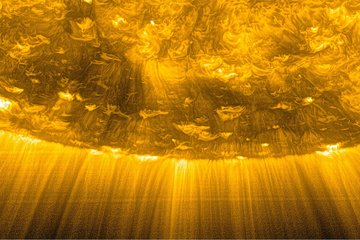Tiny plasma jets power the solar wind
Images from ESA’s Solar Orbiter offer the best look yet at a source region of the solar wind - and challenge our view of the continuous particle stream from the Sun.
Tiny plasma jets on the Sun, racing from the solar corona into space at speeds of a few hundred kilometers per second, could be the long-sought source of the solar wind. As a team of researchers led by the Max Planck Institute for Solar System Research (MPS) in Germany reports today in the journal Science, a large number of such tiny jets can be found in high-resolution images of a coronal hole taken by ESA's Solar Orbiter spacecraft in March 2022. Coronal holes appear as dark regions in images of the corona and are thought to be a starting point of the solar wind. As the analyses now show, although the plasma jets occur frequently, each one breaks off after a short time. This suggests that, upon closer inspection, the solar wind is not a uniform outflow of particles, but starts very intermittently on small scales.
View of a coronal hole near the Sun's south pole
The Sun not only emits radiation into space, but also spews a stream of charged particles such as protons and electrons. Depending on the Sun’s activity, this solar wind varies in strength, but never comes to a complete stop. The fastest particles of the solar wind reach supersonic speeds of more than 500 kilometers per second. Coronal holes are a source region of the solar wind. In images of the solar corona in ultraviolet light, these "holes" show up as dark areas. There, the field lines of the solar magnetic field do not curve back to the Sun in a loop, but extend out into interplanetary space. The images from Solar Orbiter, which the research team has now analyzed, show such a coronal hole in unprecedented detail and with a rapid sequence of images.
At the time the images were taken on March 30, 2022, Solar Orbiter had reached the closest point to the Sun on its highly elliptical orbit. From a distance of only about 50 million kilometers, the spacecraft peered at the solar corona from a shorter distance than any of its predecessors. For about half an hour, the Extreme-Ultraviolet Imager (EUI), which was in part developed and built at the MPS, was able to observe a coronal hole near the south pole.
"Exactly how the Sun manages to launch and accelerate the solar wind into space at high speeds has been unclear. Solar Orbiter's unique images offer us the opportunity to look more closely than ever before at the source regions of the solar wind, giving us a better understanding of this process," explains MPS scientist Dr. Lakshmi Pradeep Chitta, lead author of the new study.

Small bursts with huge impact
The images show a large number of tiny jets traveling at speeds of a few hundred kilometers per second from the Sun. They are a few 100 kilometers wide, elongated or Y-shaped, and quite short-lived: they fade away after about 20 to 100 seconds. The energy that each individual jet transports is also rather small: about one trillionth of the energy released by the largest explosions in our solar system, so-called X-class solar flares. That's why researchers refer to them as picoflare jets. By earthly standards, this amount of energy is nevertheless enormous: it is roughly equivalent to the amount of energy consumed by 10,000 households in Germany over the course of a year.
Taken together, the picoflare jets are nevertheless likely to provide much of the energy needed to launch solar wind particles on their supersonic journey through space. "While the jets we've now discovered are small and occur sporadically," Chitta said, "they appear to be a common phenomenon and are just about ubiquitous in the observed coronal hole." Picoflare jets could be triggered by a local restructuring of the solar magnetic field. Larger, similarly shaped jets are known to occur where open and closed field lines of the solar magnetic field interact and rearrange, releasing energy in the process.
Particle stream with a fine structure
Traditionally, the solar wind was thought to be a homogeneous particle stream fluctuating only over long periods of time. The new results challenge this view. As Solar Orbiter's temporally and spatially highly resolved observations now show, the solar wind seems to originate in the form of many tiny jets that vary on small scales - similar to how most rivers start their journey as several tiny creeks and streams from mountain tops.
"The more closely we look into the Sun's corona with Solar Orbiter, the more we find what a crucial role the smallest structures and processes play in understanding our star," said co-author Prof. Dr. Hardi Peter of the MPS. The researchers believe it is possible that still smaller jets or fainter bursts, hidden even from Solar Orbiter’s view, are at work. They now hope to learn more about the picoflare jets as the mission progresses. In the coming years, step by step Solar Orbiter will leave the ecliptic plane thus enjoying an ever-improving view of the solar polar regions and coronal holes there.












